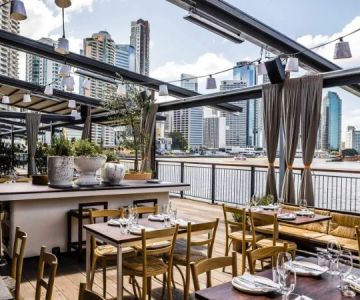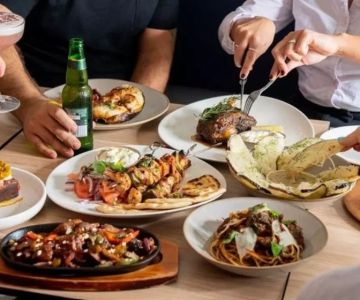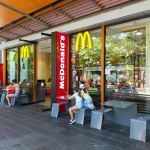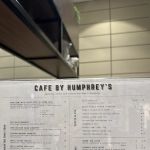
- 1-Introduction to Local Sourcing in Melbourne Restaurants
- 2-The Impact of Local Sourcing on Melbourne’s Restaurant Scene
- 3-Benefits of Local Sourcing for Melbourne Restaurants
- 4-Challenges in Local Sourcing for Restaurants
- 5-Case Study: Local Sourcing in Melbourne’s Top Restaurants
- 6-The Future of Local Sourcing in Melbourne Restaurants
- 7-Concluding Thoughts on Local Sourcing in Melbourne
1-Introduction to Local Sourcing in Melbourne Restaurants
In recent years, Melbourne's dining scene has undergone a significant transformation. One of the most noticeable shifts has been the increasing popularity of local sourcing. This practice, where restaurants source their ingredients from local farmers, producers, and suppliers, has become a hallmark of Melbourne's commitment to sustainability, quality, and supporting the local economy.
Local sourcing is changing the way chefs prepare dishes, how restaurants build their menus, and how diners engage with food. In this article, we’ll explore the impact of local sourcing on restaurants in Melbourne, the benefits it brings, the challenges it presents, and what the future holds for this approach to dining.

Dymocks Cafe
SydneyCouncil of the City of SydneyNew South Wales
Mezzanine Level, 428 George St, Sydney NSW 2000, Australia
2-The Impact of Local Sourcing on Melbourne’s Restaurant Scene
Melbourne has long been known for its dynamic food culture, offering a blend of multicultural influences and cutting-edge culinary techniques. Local sourcing has further enriched this landscape by emphasizing fresh, seasonal ingredients that are often organic, sustainable, and sourced from nearby farms or urban producers.

McDonald's Westfield Sydney
SydneyCouncil of the City of SydneyNew South Wales
Lower Ground Floor, Westfield, Central St, Sydney NSW 2000, Australia
1. Redefining Restaurant Menus
With a growing emphasis on fresh, local produce, many Melbourne restaurants have restructured their menus to highlight what is available in-season. This shift not only helps showcase the best of what local producers have to offer but also ensures that dishes are fresher, more flavorful, and unique to Melbourne’s ever-changing seasons.
2. Enhanced Dining Experience
Local sourcing allows diners to experience the flavors of their local area in a way that simply cannot be replicated with imported ingredients. The connection between farm and table is more pronounced, and diners are increasingly drawn to restaurants that emphasize transparency about where their food comes from. For many, knowing that their meal supports local farmers and reduces environmental impact adds an extra layer of satisfaction to the dining experience.
3-Benefits of Local Sourcing for Melbourne Restaurants
The trend toward local sourcing in Melbourne restaurants offers several key advantages, both for the restaurant industry and the broader community. Here’s a closer look at the main benefits:
1. Sustainability and Reduced Environmental Impact
By sourcing ingredients locally, restaurants in Melbourne are significantly reducing their carbon footprint. The transportation of food from distant locations often contributes to greenhouse gas emissions, whereas locally sourced ingredients travel shorter distances, leading to fewer emissions. This shift aligns with the growing demand for sustainable practices and makes local sourcing an essential aspect of Melbourne's culinary scene.
2. Supporting Local Economy
Local sourcing helps stimulate the local economy by supporting regional farmers, food producers, and suppliers. By choosing local ingredients, Melbourne restaurants contribute to the livelihood of these businesses, creating a positive feedback loop that strengthens the community and helps maintain the integrity of local food production.
3. Superior Quality and Freshness
Local sourcing ensures that ingredients are as fresh as possible. Melbourne’s proximity to lush farming regions allows restaurants to access high-quality produce, meats, and seafood, often harvested or produced the day before it hits the plate. Freshness directly translates into better flavor, texture, and overall dining quality—critical factors in maintaining a restaurant’s reputation for excellence.
4-Challenges in Local Sourcing for Restaurants
While the benefits of local sourcing are clear, restaurants face a variety of challenges when implementing this practice. Here are some of the most common obstacles to local sourcing:
1. Limited Availability and Seasonality
One of the biggest challenges of local sourcing is the seasonal nature of many ingredients. Not all items are available year-round, which can make menu planning difficult. Restaurants must be flexible, adjusting their offerings to make use of ingredients that are in-season, which may not always align with customer preferences for certain dishes.
2. Higher Costs
Locally sourced ingredients can sometimes be more expensive than mass-produced, imported alternatives. Small-scale farmers and producers often cannot compete on price with large commercial suppliers, which may drive up costs for restaurants. To offset these costs, many Melbourne restaurants incorporate local sourcing into a larger strategy of premium pricing or offering specialized menu items that justify the higher expense.
3. Supply Chain Logistics
Managing a consistent and reliable supply of local ingredients can be a logistical challenge, particularly when dealing with smaller suppliers who may have limited stock or production. Restaurants need to build strong relationships with their suppliers to ensure consistent delivery and to manage the risk of shortages or price fluctuations.
5-Case Study: Local Sourcing in Melbourne’s Top Restaurants
One restaurant that exemplifies the impact of local sourcing in Melbourne is Attica, located in Ripponlea. Attica, led by chef Ben Shewry, has long been a champion of using Australian ingredients and sourcing products from local, sustainable farms. Their menu changes regularly to reflect seasonal ingredients and their commitment to using only the best local produce.
For example, Attica has developed close relationships with farmers in Victoria, ensuring that the vegetables, meats, and seafood they use are of the highest quality. By collaborating with these local producers, the restaurant not only supports small-scale farming but also contributes to the sustainability of the industry. The outcome is a dining experience that is both rooted in local traditions and innovative in its approach, offering a truly authentic taste of Melbourne’s food culture.
6-The Future of Local Sourcing in Melbourne Restaurants
Looking ahead, local sourcing is poised to continue playing a key role in shaping Melbourne's restaurant industry. As consumers increasingly demand transparency, sustainability, and fresh ingredients, restaurants that embrace local sourcing are likely to remain at the forefront of the culinary scene.
Advancements in food technology, including vertical farming and local food hubs, may help mitigate some of the logistical challenges associated with sourcing locally. This, in turn, could make it easier for restaurants to access a wider variety of high-quality ingredients year-round.
Moreover, as awareness about the environmental impact of food production grows, the demand for sustainable, local dining options will likely increase. This creates an exciting future for both restaurants and diners, as Melbourne continues to evolve as a hub for food lovers seeking authentic, locally sourced meals.
7-Concluding Thoughts on Local Sourcing in Melbourne
Local sourcing is transforming the restaurant industry in Melbourne by prioritizing fresh, sustainable ingredients and supporting the local economy. While it presents challenges such as higher costs and logistical concerns, the benefits—including superior food quality, sustainability, and stronger community connections—make it a worthwhile endeavor for many restaurants. The future of dining in Melbourne looks bright as local sourcing continues to reshape the culinary landscape, offering diners an authentic and rewarding dining experience.
If you’re looking for more tips on Melbourne’s best local restaurants or want to explore sustainable dining options, check out Sydney Eats Explorer for expert recommendations and curated food experiences.







 Harry's Café de Wheels - Darling Quarter3.0 (119 reviews)
Harry's Café de Wheels - Darling Quarter3.0 (119 reviews) Little Sparrow QVB3.0 (46 reviews)
Little Sparrow QVB3.0 (46 reviews) McDonald's Darling Quarter3.0 (825 reviews)
McDonald's Darling Quarter3.0 (825 reviews) Vogue Cafe Sydney4.0 (1880 reviews)
Vogue Cafe Sydney4.0 (1880 reviews) Georgie Boy's Coffee Co - Westfield Sydney Central Plaza4.0 (56 reviews)
Georgie Boy's Coffee Co - Westfield Sydney Central Plaza4.0 (56 reviews) Cafe 683.0 (18 reviews)
Cafe 683.0 (18 reviews) How Local Sourcing Is Changing the Game for Restaurants in Melbourne
How Local Sourcing Is Changing the Game for Restaurants in Melbourne The Best Dining Spots in Melbourne for Breakfast Meet-ups and Business Brunches
The Best Dining Spots in Melbourne for Breakfast Meet-ups and Business Brunches How Restaurants Are Using Data Analytics to Forecast Food Trends in Australia
How Restaurants Are Using Data Analytics to Forecast Food Trends in Australia The Best Sushi and Sashimi Restaurants in Perth for Premium Seafood Lovers
The Best Sushi and Sashimi Restaurants in Perth for Premium Seafood Lovers How Australian Restaurants Are Using Social Proof and Reviews to Attract Diners | Sydney Eats Explorer
How Australian Restaurants Are Using Social Proof and Reviews to Attract Diners | Sydney Eats Explorer How Restaurants in Australia Are Using Augmented Reality for Wine Pairing Menus
How Restaurants in Australia Are Using Augmented Reality for Wine Pairing Menus